Soil Moisture Monitoring and Evaluation in Agricultural Fields Based on NDVI Long Time Series and CEEMDAN
Abstract
:1. Introduction
- (1)
- A new soil moisture content inversion model was constructed by combining the CEEMDAN with the PLSR algorithm, and the model has better accuracy and stability, providing a new solution for real-time and accurate soil moisture monitoring;
- (2)
- The CEEMDAN algorithm is applied to the screening and extraction of soil moisture stress, developing the application of CEEMDAN in the field of soil moisture research. CEEMDAN can effectively decompose the NDVI long time series and accurately extract the characteristic components of soil moisture stress, making the inversion results more accurate;
- (3)
- The optimal decomposition parameter epsilon of CEEMDAN and the optimal inversion model type of PLSR were determined experimentally, and the optimal inversion model based on CEEMDAN and PLSR for soil moisture content inversion was explored to further improve its generalization capability and accuracy;
- (4)
- The effective inversion of soil moisture content and the analysis of spatiotemporal distribution characteristics in the study area were completed based on the optimal inversion model, providing a scientific basis for drought management and agricultural planning.
2. Materials and Methods
2.1. Study Area
2.1.1. Geographical Location and Landforms
2.1.2. Climate and Vegetation Characteristics
2.1.3. Hydrological and Geological Profile
2.2. Data Sources
2.2.1. Remote Sensing Data
2.2.2. Ground-Measured Data
- (1)
- Relative chlorophyll content determination
- (2)
- Plant moisture content determination
- (3)
- Soil moisture content determination
2.3. Methods
2.3.1. Technical Flow
2.3.2. EEMD and CEEMDAN
2.3.3. Construction of the Soil Moisture Stress Response Index
2.3.4. Model Construction and Accuracy Evaluation
3. Results
3.1. The NDVI Long Time Series
3.2. Comparison between EEMD and CEEMDAN
3.3. Identification of Soil Moisture Stress Components
3.3.1. Decomposition Results of NDVI Long Time Series
3.3.2. Identification of Soil Moisture Stress Components
3.4. Soil Moisture Stress Response Index
3.5. Construction and Validation of the Inversion Model
3.6. Spatial and Temporal Distribution of Soil Moisture Content
3.6.1. Spatial Distribution Characteristics of Soil Moisture Content
3.6.2. Temporal Distribution Characteristics of Soil Moisture Content
4. Discussion
5. Conclusions
- (1)
- The CEEMDAN algorithm decomposes the data with higher reconstruction accuracy, reduces the interference of noise on NDVI long time series and preserves the details of the data. It excludes the impact of other noise stress factors, which facilitates the accurate screening of soil moisture stress and improves the accuracy of soil moisture content inversion;
- (2)
- Two response indices can exactly present the response of chlorophyll content and wheat moisture content to soil moisture stress. The CEEMDAN algorithm gives the best decomposition when the ratio of added noise is set to 0.05. Meanwhile, when the inversion model type is a quadratic model, the model determination coefficient R2 reaches a maximum of 0.981, with a high degree of model fit and low error, and the Qudratic CEEMDAN–PLSR inversion model has high inversion accuracy and stability;
- (3)
- The effective soil moisture content in the study area is relatively low. The degree of soil moisture stress gradually decreases from February to May, and attention should be paid to the management of spring irrigation in April, the timely replenishment of farm moisture and the appropriate strengthening of real-time soil moisture monitoring to the central part, especially the south-central part.
Author Contributions
Funding
Data Availability Statement
Conflicts of Interest
References
- Zhao, J.; Zhang, C.; Min, L.; Guo, Z.; Li, N. Retrieval of Farmland Surface Soil Moisture Based on Feature Optimization and Machine Learning. Remote Sens. 2022, 14, 5102. [Google Scholar] [CrossRef]
- Zhang, Y.; Liu, X.; Jiao, W.; Zeng, X.; Xing, X.; Zhang, L.; Yan, J.; Hong, Y. Drought monitoring based on a new combined remote sensing index across the transitional area between humid and arid regions in China. Atmos. Res. 2021, 264, 105850. [Google Scholar] [CrossRef]
- Mirzaei, A.; Naseri, R.; Moghadam, A.; Esmailpour-Jahromi, M. The effects of drought stress on seed yield and some agronomic traits of canola cultivars at different growth stages. Bull. Environ. Pharmacol. Life Sci. 2013, 2, 115–121. [Google Scholar]
- Kapoor, D.; Bhardwaj, S.; Landi, M.; Sharma, A.; Ramakrishnan, M.; Sharma, A. The Impact of Drought in plant metabolism: How to exploit tolerance mechanisms to increase crop production. Appl. Sci. 2020, 10, 5692. [Google Scholar] [CrossRef]
- Huang, S.; Huang, Q.; Chang, J.; Leng, J.; Xing, L. The response of agricultural drought to meteorological drought and the influencing factors: A case study in the Wei River Basin, China. Agric. Water Manag. 2015, 159, 45–54. [Google Scholar] [CrossRef]
- Wu, X.; Bai, M.; Li, Y.; Du, T.; Zhang, S.; Shi, Y. Effect of water and fertilizer coupling on root growth, soil water and nitrogen distribution of cabbage with drip irrigation under mulch. Trans. Chin. Soc. Agric. Eng. 2019, 35, 110–119. [Google Scholar]
- Liu, M.; Liu, X.; Zhang, B.; Ding, C. Regional heavy metal pollution in crops by integrating physiological function variability with spatio-temporal stability using multi-temporal thermal remote sensing. Int. J. Appl. Earth Obs. Geoinf. 2016, 51, 91–102. [Google Scholar] [CrossRef]
- Liu, M.; Wang, T.; Skidmore, A.; Liu, X. Heavy metal-induced stress in rice crops detected using multi-temporal Sentinel-2 satellite images. Sci. Total Environ. 2018, 637–638, 18–29. [Google Scholar] [CrossRef]
- Cui, T.; Zhang, Z.; Cui, C.; Bian, J.; Chen, S.; Wang, H. Study on Variation Curve and Fitting Model of Winter Wheat Canopy NDVI. Water Sav. Irrig. 2018, 12, 97–103. [Google Scholar]
- Wang, Q.; Li, M.; Li, G.; Zhang, J.; Yan, S.; Chen, Z.; Zhang, X.; Chen, G. High-Resolution Remote Sensing Image Change Detection Method Based on Improved Siamese U-Net. Remote Sens. 2023, 15, 3517. [Google Scholar] [CrossRef]
- Wang, R.; Zhao, J.; Yang, H.; Li, N. Inversion of Soil Moisture on Farmland Areas Based on SSA-CNN Using Multi-Source Remote Sensing Data. Remote Sens. 2023, 15, 2515. [Google Scholar] [CrossRef]
- Milewski, R.; Schmid, T.; Chabrillat, S.; Jiménez, M.; Escribano, P.; Pelayo, M.; Ben-Dor, E. Analyses of the Impact of Soil Conditions and Soil Degradation on Vegetation Vitality and Crop Productivity Based on Airborne Hyperspectral VNIR–SWIR–TIR Data in a Semi-Arid Rainfed Agricultural Area (Camarena, Central Spain). Remote Sens. 2022, 14, 5131. [Google Scholar] [CrossRef]
- Albertini, C.; Gioia, A.; Iacobellis, V.; Manfreda, S. Detection of Surface Water and Floods with Multispectral Satellites. Remote Sens. 2022, 14, 6005. [Google Scholar] [CrossRef]
- Liu, S.; Tian, W.; Yin, Y.; An, N.; Dong, S. Temporal dynamics of vegetation NDVI and its response to drought conditions in Yunnan Province. Acta Ecol. Sin. 2016, 36, 4699–4707. [Google Scholar]
- Celik, M.F.; Isik, M.S.; Yuzugullu, O.; Fajraoui, N.; Erten, E. Soil Moisture Prediction from Remote Sensing Images Coupled with Climate, Soil Texture and Topography via Deep Learning. Remote Sens. 2022, 14, 5584. [Google Scholar] [CrossRef]
- Liu, W.; Zhu, S.; Huang, Y.; Wan, Y.; Wu, B.; Liu, L. Spatiotemporal Variations of Drought and Their Teleconnections with Large-Scale Climate Indices over the Poyang Lake Basin, China. Sustainability 2020, 12, 3526. [Google Scholar] [CrossRef]
- Hirschberg, V.; Rodrigue, D. Fourier Transform (FT) Analysis of the Stress as a Tool to Follow the Fatigue Behavior of Metals. Appl. Sci. 2021, 11, 8. [Google Scholar] [CrossRef]
- Hien, L.T.T.; Gobin, A.; Lim, D.T.; Quan, D.T.; Hue, N.T.; Thang, N.N.; Binh, N.T.; Dung, V.T.K.; Linh, P.H. Soil Moisture Influence on the FTIR Spectrum of Salt-Affected Soils. Remote Sens. 2022, 14, 2380. [Google Scholar] [CrossRef]
- Zhang, M.; Zhou, Q.; Chen, Z.; Jia, L.; Zhou, Y.; Cai, C. Crop discrimination in Northern China with double cropping systems using Fourier analysis of time-series MODIS data. Int. J. Appl. Earth Obs. Geoinf. 2008, 10, 476–485. [Google Scholar]
- Lokeshwara, R.; Pawar, S.; Prathapa, R. Curvelet Transform based Denoising of Multispectral Remote Sensing Images. J. Phys. Conf. Ser. 2021, 1, 2089. [Google Scholar] [CrossRef]
- Wongsaroj, W.; Hamdani, A.; Thong-Un, N.; Takahashi, H.; Kikura, H. Extended Short-Time Fourier Transform for Ultrasonic Velocity Profiler on Two-Phase Bubbly Flow Using a Single Resonant Frequency. Appl. Sci. 2018, 9, 50. [Google Scholar] [CrossRef]
- Yang, C.; Liu, P.; Yin, G.; Jiang, H.; Li, X. Defect detection in magnetic tile images based on stationary wavelet transform. NDT E Int. 2016, 83, 78–87. [Google Scholar] [CrossRef]
- Feng, X.; Zhang, W.; Su, X.; Xu, Z. Optical Remote Sensing Image Denoising and Super-Resolution Reconstructing Using Optimized Generative Network in Wavelet Transform Domain. Remote Sens. 2021, 13, 1858. [Google Scholar] [CrossRef]
- Ebrahimi, K.; Taghizadeh, M.; Kazemi, M.; Nafarzadegan, R. Predicting the ground-level pollutants concentrations and identifying the influencing factors using machine learning, wavelet transformation, and remote sensing techniques. Atmos. Pollut. Res. 2021, 12, 5. [Google Scholar] [CrossRef]
- Hu, Z.; Chai, L.; Crow, W.T.; Liu, S.; Zhu, Z.; Zhou, J.; Qu, Y.; Liu, J.; Yang, S.; Lu, Z. Applying a Wavelet Transform Technique to Optimize General Fitting Models for SM Analysis: A Case Study in Downscaling over the Qinghai–Tibet Plateau. Remote Sens. 2022, 14, 3063. [Google Scholar] [CrossRef]
- Liu, Z.; Zhao, L.; Peng, Y.; Wang, G.; Hu, Y. Improving Estimation of Soil Moisture Content Using a Modified Soil Thermal Inertia Model. Remote Sens. 2020, 12, 1719. [Google Scholar] [CrossRef]
- Li, D.; Che, X.; Luo, W.; Hu, Y.; Wang, Y.; Yu, Z.; Yuan, L. Digital watermarking scheme for colour remote sensing image based on quaternion wavelet transform and tensor decomposition. Math. Methods Appl. Sci. 2019, 42, 4664–4678. [Google Scholar] [CrossRef]
- Zhang, C.; Liu, J.; Su, W.; Qiao, M.; Zhu, D. Optimal scale of crop classification using unmanned aerial vehicle remote sensing imagery based on wavelet packet transform. Editor. Off. Trans. Chin. Soc. Agric. Eng. 2016, 32, 95–101. [Google Scholar]
- Masoud, M. Wavelet transform approach for denoising and decomposition of satellite-derived ocean color time-series: Selection of optimal mother wavelet. Adv. Space Res. 2022, 69, 2724–2744. [Google Scholar]
- Wang, C.; Sun, W.; Fan, D.; Liu, X.; Zhang, Z. Adaptive Feature Weighted Fusion Nested U-Net with Discrete Wavelet Transform for Change Detection of High-Resolution Remote Sensing Images. Remote Sens. 2021, 13, 4971. [Google Scholar] [CrossRef]
- Nassar, A.; Torres-Rua, A.; Hipps, L.; Kustas, W.; McKee, M.; Stevens, D.; Nieto, H.; Keller, D.; Gowing, I.; Coopmans, C. Using Remote Sensing to Estimate Scales of Spatial Heterogeneity to Analyze Evapotranspiration Modeling in a Natural Ecosystem. Remote Sens. 2022, 14, 372. [Google Scholar] [CrossRef]
- Asim, B. Scale–location specific soil spatial variability: A comparison of continuous wavelet transform and Hilbert–Huang transform. Catena 2018, 160, 24–31. [Google Scholar]
- Wang, X.; Liu, A.; Zhang, Y.; Xue, F. Underwater Acoustic Target Recognition: A Combination of Multi-Dimensional Fusion Features and Modified Deep Neural Network. Remote Sens. 2019, 11, 1888. [Google Scholar] [CrossRef]
- Fu, P.; Zhang, W.; Yang, K.; Meng, F. A novel spectral analysis method for distinguishing heavy metal stress of maize due to copper and lead: RDA and EMD-PSD. Ecotoxicol. Environ. Saf. 2020, 206, 111211. [Google Scholar] [CrossRef]
- Prasad, R. Streamflow and soil moisture forecasting with hybrid data intelligent machine learning approaches: Case studies in the Australian Murray-Daring basin. Bull. Aust. Math. Soc. 2019, 100, 520–522. [Google Scholar] [CrossRef]
- Cordes, D.; Kaleem, M.F.; Yang, Z.; Zhuang, X.; Curran, T.; Sreenivasan, K.R.; Mishra, V.R.; Nandy, R.; Walsh, R. Energy-Period Profiles of Brain Networks in Group fMRI Resting-State Data: A Comparison of Empirical Mode Decomposition With the Short-Time Fourier Transform and the Discrete Wavelet Transform. Front. Neurosci. 2021, 15, 663403. [Google Scholar] [CrossRef]
- Zhang, X.; Feng, X.; Zhang, Z.; Kang, Z.; Chai, Y.; You, Q.; Ding, L. Dip Filter and Random Noise Suppression for GPR B-Scan Data Based on a Hybrid Method in f–x Domain. Remote Sens. 2019, 11, 2180. [Google Scholar] [CrossRef]
- Fan, G.F.; Peng, L.L.; Zhao, X.; Hong, W.C. Applications of Hybrid EMD with PSO and GA for an SVR-Based Load Forecasting Model. Energies 2017, 10, 1713. [Google Scholar] [CrossRef]
- Lu, P.; Ye, L.; Sun, B.; Zhang, C.; Zhao, Y.; Zhu, T. A new hybrid prediction method of ultra-short-term wind power forecasting based on EEMD-PE and LSSVM optimized by the GSA. Energies 2018, 11, 697. [Google Scholar] [CrossRef]
- Wu, Z.; Huang, N.E. Ensemmble empirical mode decomposition: A noise-assisted data analysis method. Adv. Adapt. Data Anal. 2005, 1, 1–41. [Google Scholar] [CrossRef]
- Li, T.Y.; Zhou, M.; Guo, C.Q.; Luo, M.; Wu, J.; Pan, F.; Tao, Q.Y.; He, T. Forecasting crude oil price using EEMD and RVM with adaptive pso-based kernels. Energies 2016, 9, 1014. [Google Scholar] [CrossRef]
- Torres, M.E.; Colominas, M.A.; Schlotthauer, G.; Flandrin, P. A complete ensemble empirical mode decomposition with adaptive noise. In Proceedings of the 2011 IEEE International Conference on Acoustics, Speech and Signal Processing, Prague, Czech Republic, 22–27 May 2011; pp. 4144–4147. [Google Scholar]
- Colominas, M.A.; Schlotthauer, G.; Torres, M.E. Improved complete ensemble EMD: A suitable tool for biomedical signal processing. Biomed. Signal Process. Control 2014, 14, 19–29. [Google Scholar] [CrossRef]
- Yang, Z.; Zou, L.; Xia, J.; Qiao, Y.; Cai, D. Inner Dynamic Detection and Prediction of Water Quality Based on CEEMDAN and GA-SVM Models. Remote Sens. 2022, 14, 1714. [Google Scholar] [CrossRef]
- Yeh, J.-R.; Shieh, J.-S.; Huang, N.E. Complementary Ensemble Empirical Mode Decomposition: A Novel Noise Enhanced Data Analysis Method. Adv. Adapt. Data Anal. 2011, 2, 135–156. [Google Scholar] [CrossRef]
- Ahmed, A.A.M.; Deo, R.C.; Raj, N.; Ghahramani, A.; Feng, Q.; Yin, Z.; Yang, L. Deep Learning Forecasts of Soil Moisture: Convolutional Neural Network and Gated Recurrent Unit Models Coupled with Satellite-Derived MODIS, Observations and Synoptic-Scale Climate Index Data. Remote Sens. 2021, 13, 554. [Google Scholar] [CrossRef]
- Liu, Y.; Feng, H.; Yue, J.; Li, Z.; Jin, X.; Fan, Y.; Feng, Z.; Yang, G. Estimation of Aboveground Biomass of Potatoes Based on Characteristic Variables Extracted from UAV Hyperspectral Imagery. Remote Sens. 2022, 14, 5121. [Google Scholar] [CrossRef]
- Xu, Y.; Gong, H.; Chen, B.; Zhang, Q.; Li, Z. Long-term and seasonal variation in groundwater storage in the North China Plain based on GRACE. Int. J. Appl. Earth Obs. Geoinf. 2021, 104, 102560. [Google Scholar] [CrossRef]
- Xu, Y.; Sun, Y.; Xu, T. Survey Research on Coordinated Disposal of Contaminated Soil by Cement Kiln in Hebei Province. Chem. Enterp. Manag. 2021, 33, 28–30. [Google Scholar]
- Jia, L.; Liu, K.; Huang, S.; Yang, Y.; Yang, J.; Zhang, P.; Hao, L.; Xing, S. Phosphorus and Potassium Nutrient Abundance and Deficiency Index and Fertilization Target of Summer Maize Farmland in Hebei Plain. Jiangsu Agric. Sci. 2021, 49, 75–79. [Google Scholar]
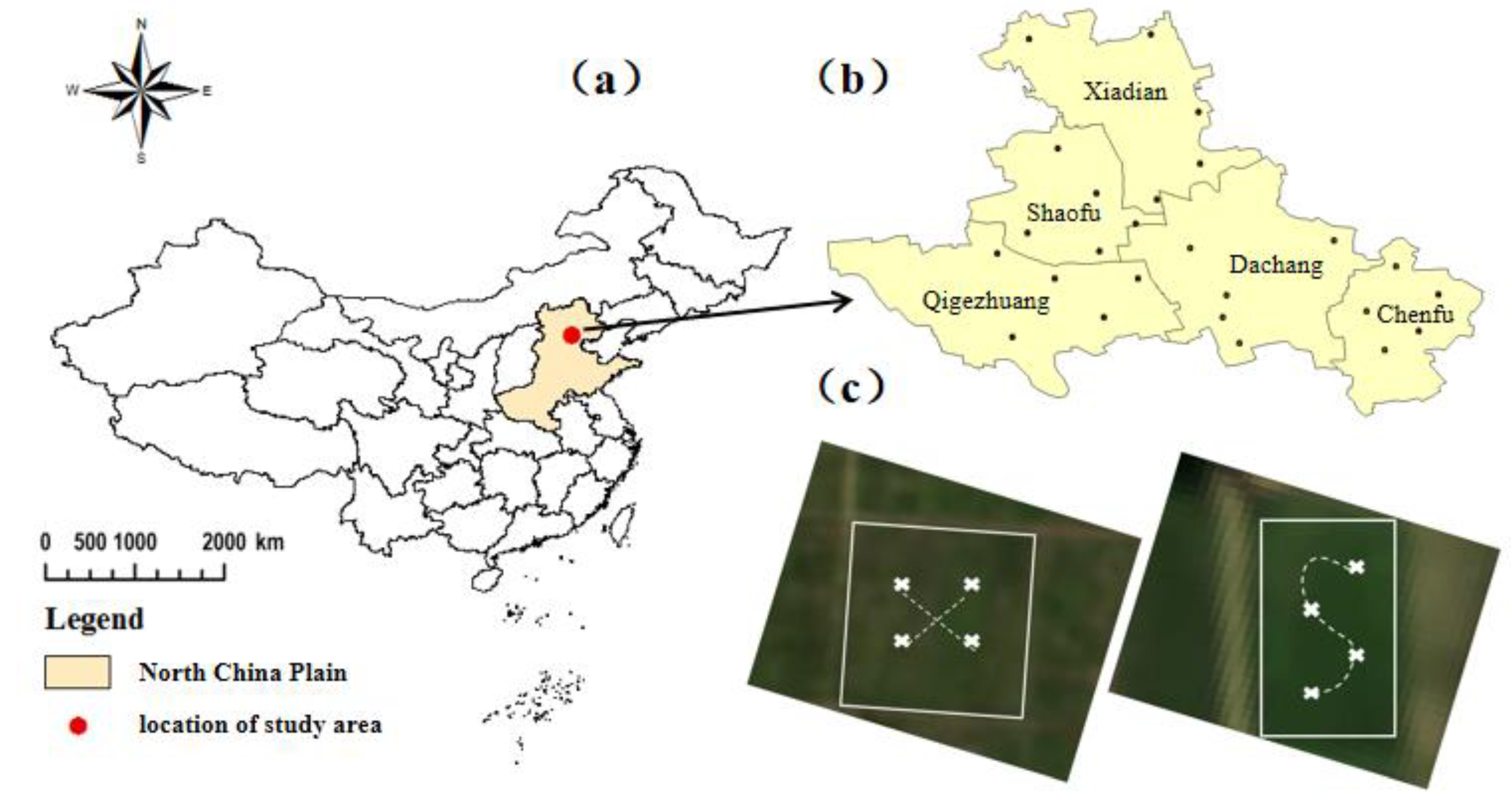

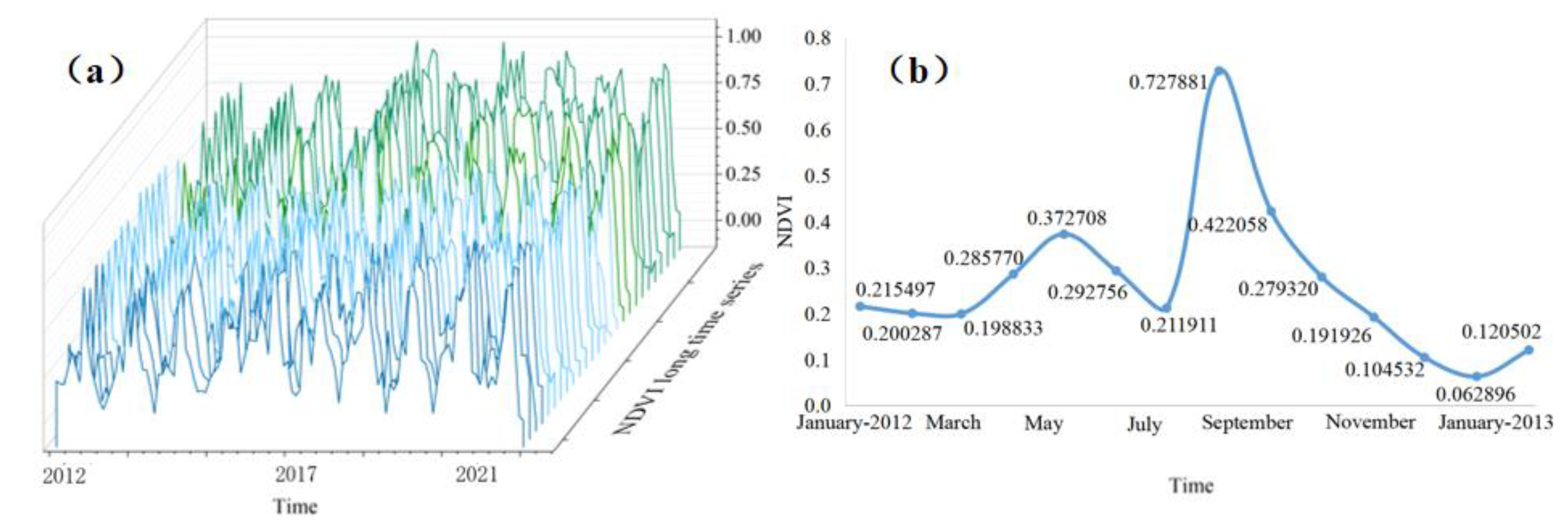
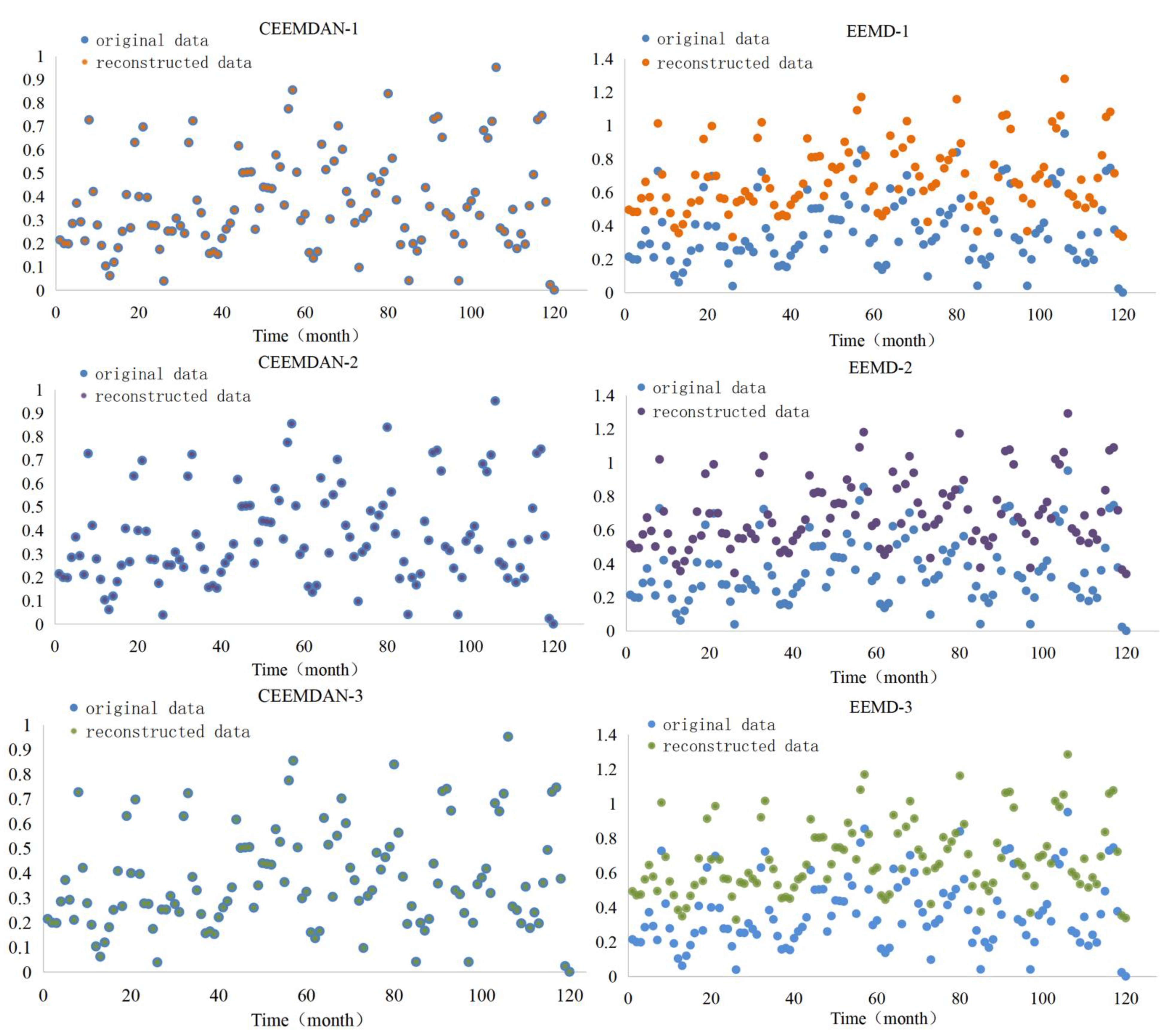
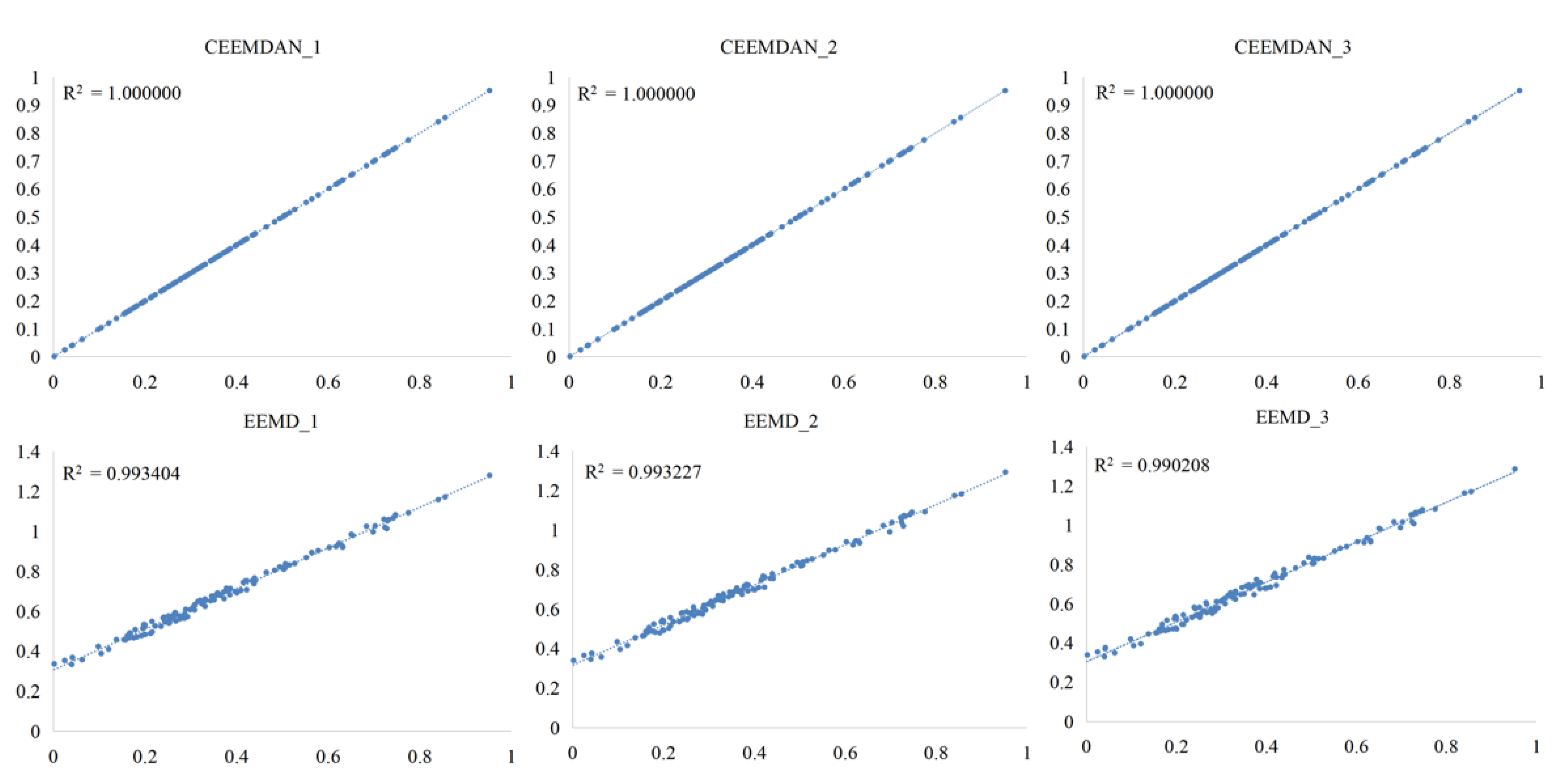
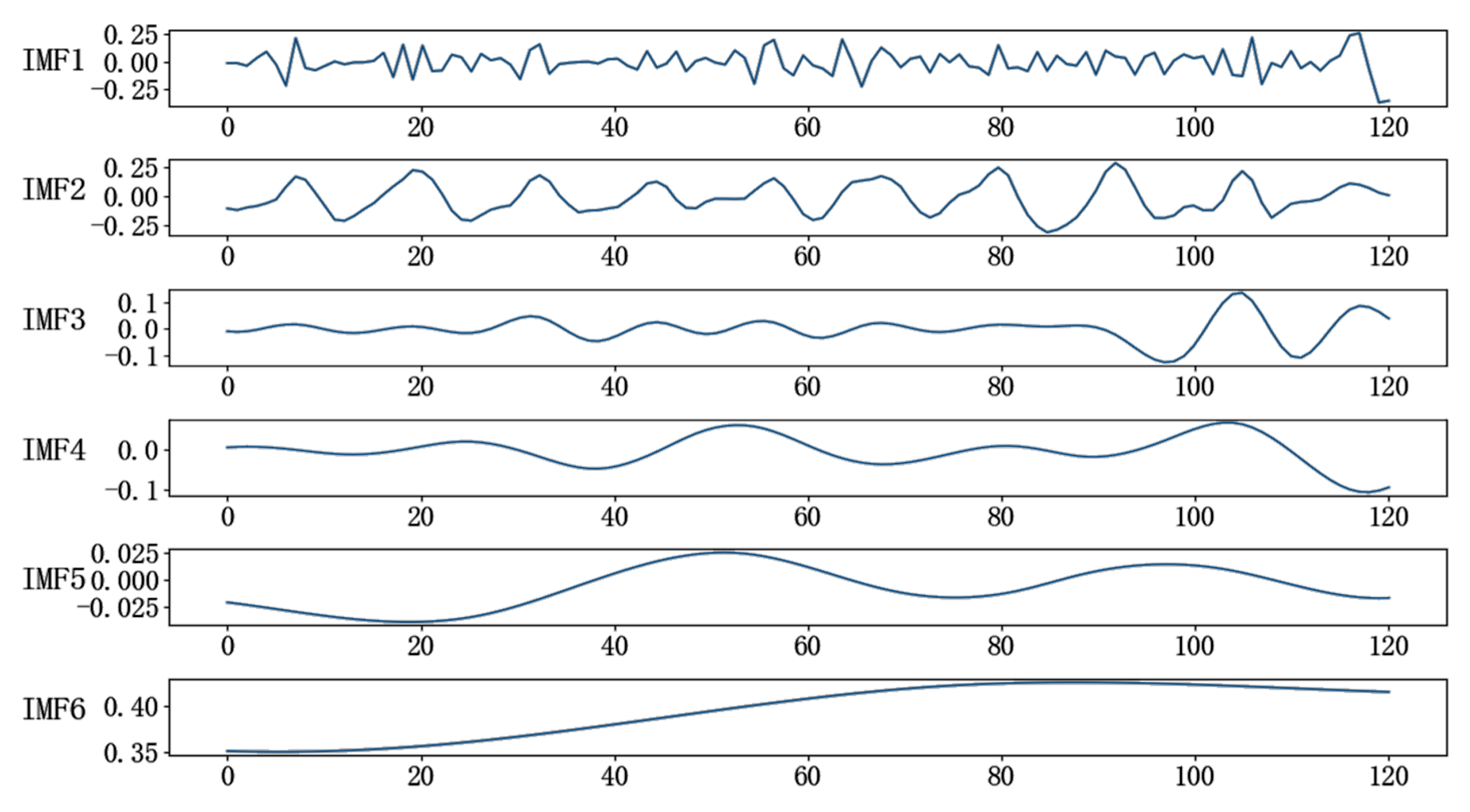
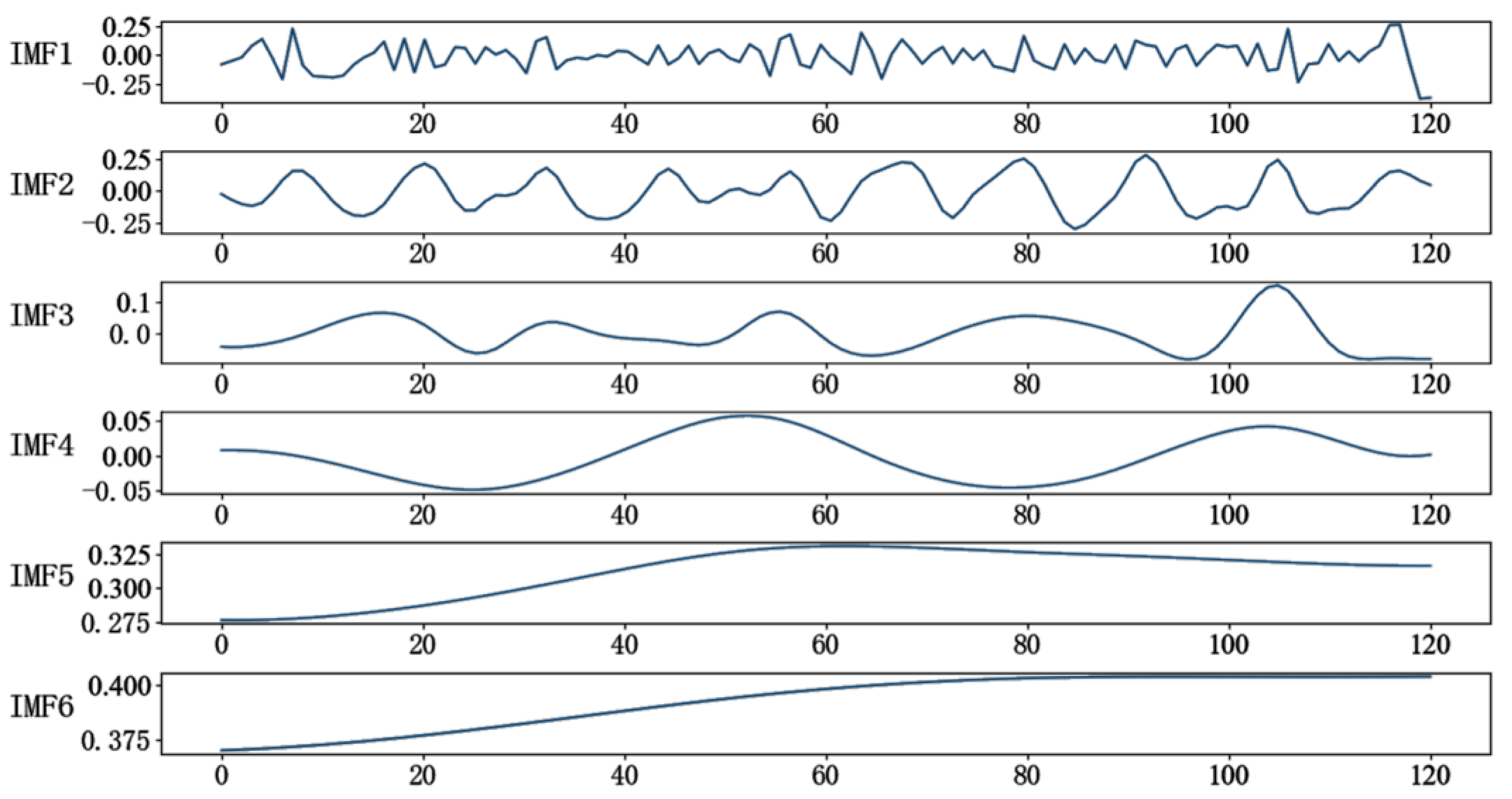
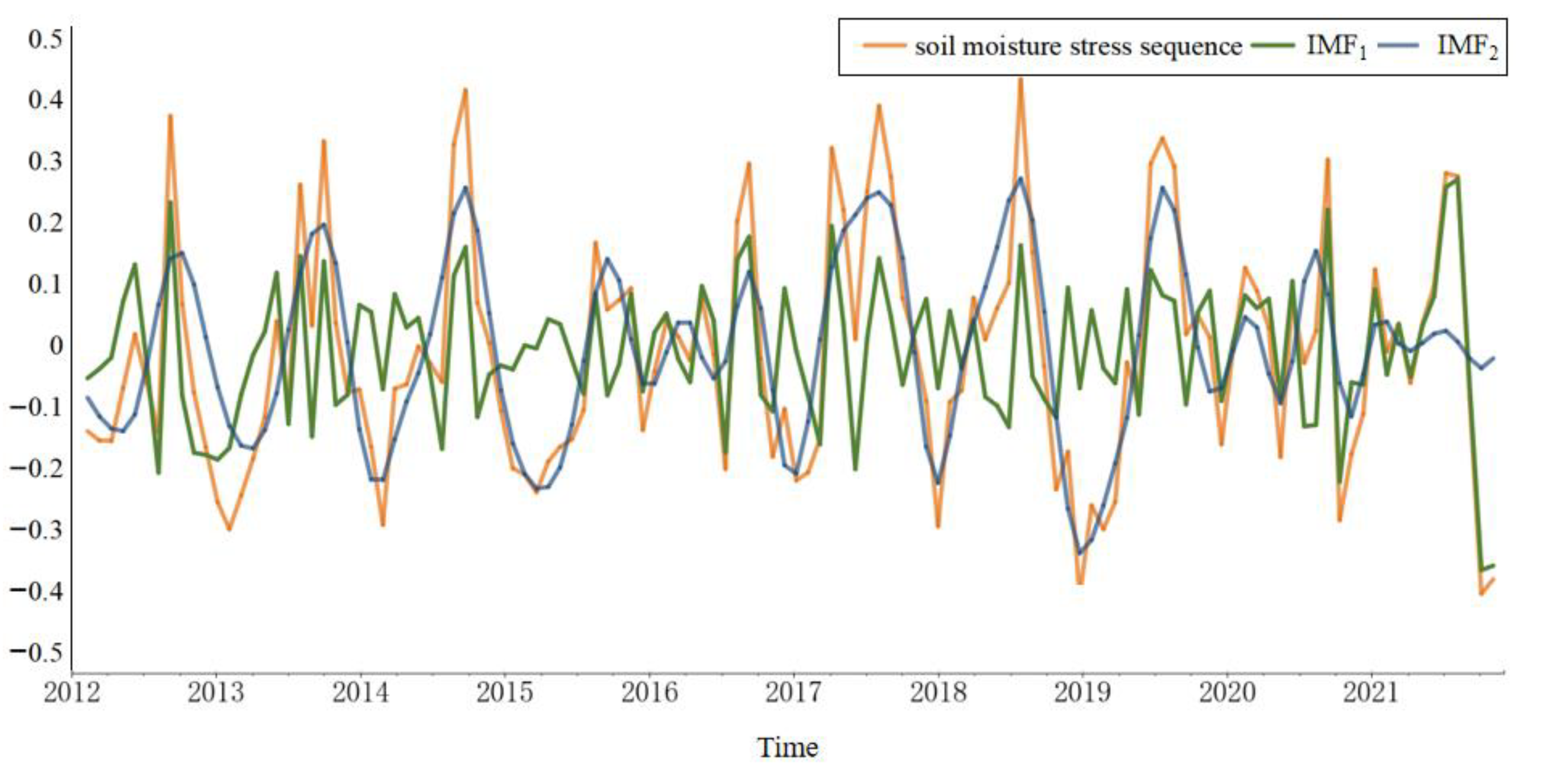
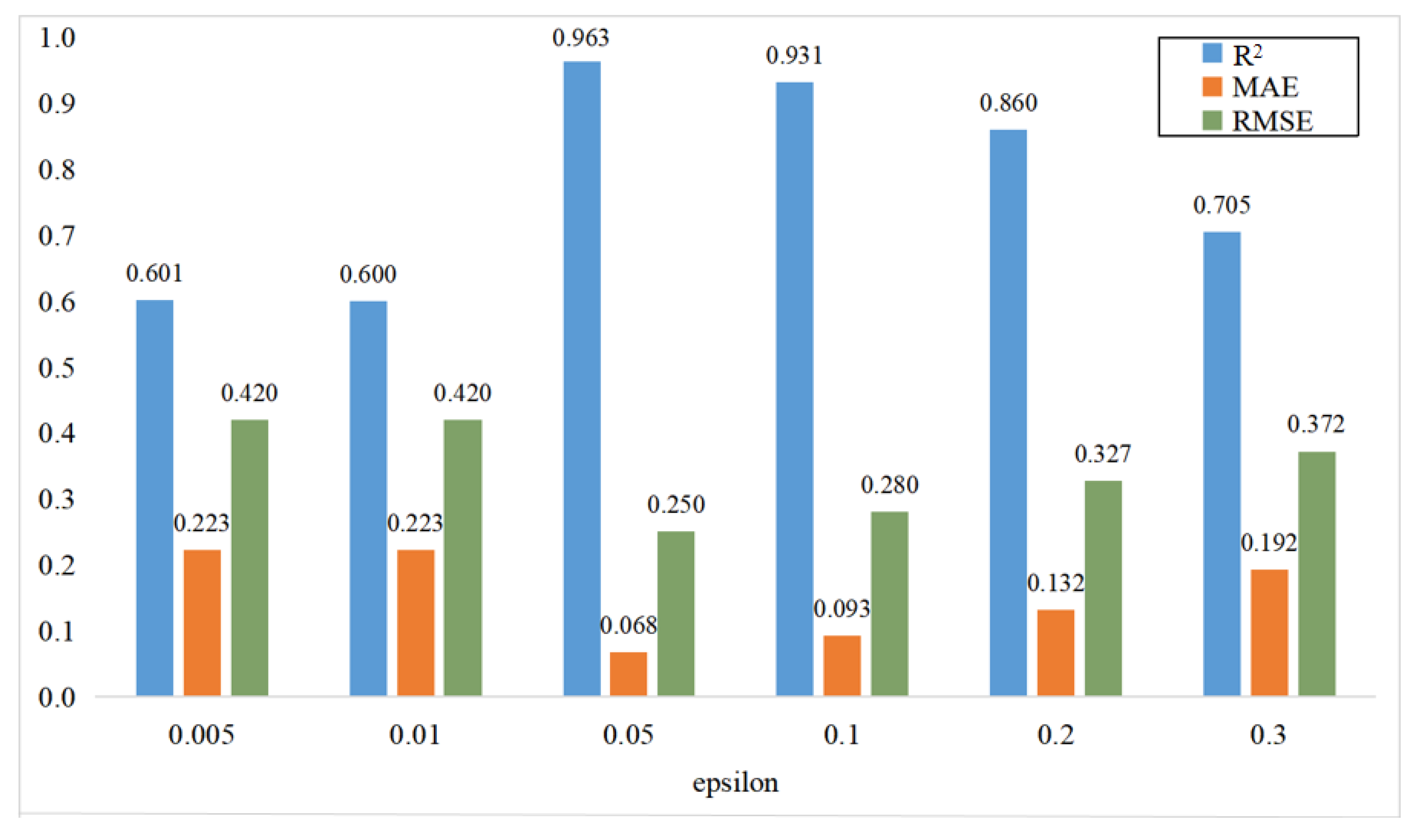

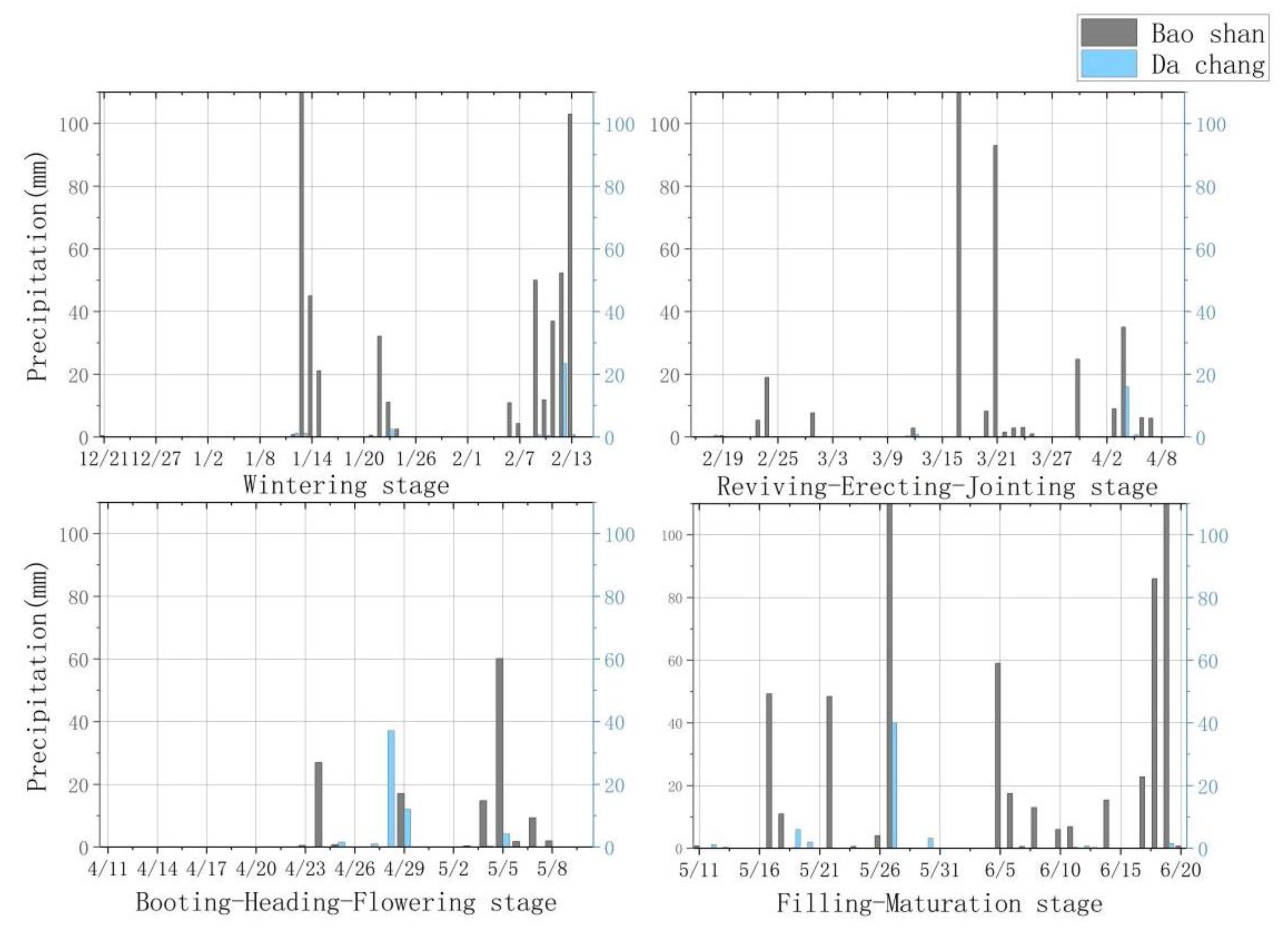
| Stage | Duration | Sample Time | Characteristics |
|---|---|---|---|
| Jointing stage | Mid-March to early April | 4 April | The internodes above the ground grew about 2 cm and exhibited relatively low water consumption. |
| Booting stage | Early April to mid-April | 17 April | All leaves extended out of the leaf sheath, and the water demand gradually increased. |
| Heading stage | Mid-April to early May | 2 May | More than half of the tops of wheat ears had leaf sheaths showing, and a lack of water could severely reduce yields. |
| Flowering stage | Early May to mid-May | 13 May | More than half of the wheat ears bloomed, and they had relatively high water requirements. |
| Filing stage | Mid-May to early June | 25 May | The plant moisture content rapidly increased, and dry matter accumulation tended to be at its maximum. |
| IMF | Fluctuation Period | Mean Value | Variance | Variance Contribution Rate | Pearson Correlation Coefficient |
|---|---|---|---|---|---|
| IMF1 | 1.600 | −0.011 | 0.013 | 0.322 | 0.606 ** |
| IMF2 | 4.286 | −0.007 | 0.019 | 0.476 | 0.693 ** |
| IMF3 | 8.000 | 0.002 | 0.007 | 0.160 | 0.304 ** |
| IMF4 | 13.333 | −0.001 | 0.002 | 0.042 | 0.133 * |
| IMF5 | 20.000 | −0.003 | 0.001 | 0.011 | 0.197 * |
| IMF6 | 60.000 | 0.392 | 0.000 | 0.001 | 0.228 * |
| Stage | Relative Chlorophyll Content (SPAD) | PMC (%) | SMC (%) |
|---|---|---|---|
| Jointing stage | 54.3 | 78.1 | 11.2 |
| 48.4 | 81.7 | 11.5 | |
| 54.0 | 82.6 | 14.8 | |
| 47.9 | 81.2 | 9.9 | |
| Booting stage | 47.5 | 82.4 | 9.5 |
| 49.3 | 79.0 | 11.4 | |
| 45.3 | 76.5 | 9.3 | |
| 46.5 | 80.8 | 10.8 | |
| Heading stage | 50.3 | 82.3 | 10.5 |
| 49.5 | 76.5 | 10.6 | |
| 52.1 | 76.3 | 9.6 | |
| 54.8 | 80.3 | 14.1 | |
| Flowering stage | 50.4 | 69.4 | 9.6 |
| 62.0 | 76.9 | 13.4 | |
| 59.1 | 73.9 | 10.6 | |
| 56.5 | 77.1 | 12.3 | |
| Filing stage | 52.6 | 71.5 | 11.7 |
| 66.9 | 71.3 | 9.2 | |
| 62.9 | 70.4 | 10.1 | |
| 57.4 | 69.6 | 11.0 |
| Algorithm | Number of Tests | Model Type | Model Accuracy Evaluation Index | |||
|---|---|---|---|---|---|---|
| R2 | MAE | RMSE | p-Value | |||
| CEEMDAN | 1 | Linear | 0.841 | 0.141 | 0.336 | 8.14 × 10−3 |
| Quadratic | 0.931 | 0.093 | 0.288 | 4.85 × 10−3 | ||
| Cubic | 0.874 | 0.125 | 0.320 | 7.36 × 10−3 | ||
| 2 | Linear | 0.903 | 0.110 | 0.314 | 5.62 × 10−3 | |
| Quadratic | 0.981 | 0.048 | 0.202 | 9.75 × 10−4 | ||
| Cubic | 0.960 | 0.070 | 0.236 | 3.51 × 10−3 | ||
| 3 | Linear | 0.900 | 0.112 | 0.315 | 5.74 × 10−3 | |
| Quadratic | 0.979 | 0.051 | 0.210 | 9.83 × 10−4 | ||
| Cubic | 0.957 | 0.073 | 0.239 | 4.07 × 10−3 | ||
| Model Type | Regression Equation | R2 | MAE | RMSE | Error (%) |
|---|---|---|---|---|---|
| Linear | 0.903 | 0.110 | 0.314 | 11.203 | |
| Quadratic | 0.981 | 0.048 | 0.202 | 7.926 | |
| Cubic | 0.960 | 0.070 | 0.236 | 8.518 |
Disclaimer/Publisher’s Note: The statements, opinions and data contained in all publications are solely those of the individual author(s) and contributor(s) and not of MDPI and/or the editor(s). MDPI and/or the editor(s) disclaim responsibility for any injury to people or property resulting from any ideas, methods, instructions or products referred to in the content. |
© 2023 by the authors. Licensee MDPI, Basel, Switzerland. This article is an open access article distributed under the terms and conditions of the Creative Commons Attribution (CC BY) license (https://creativecommons.org/licenses/by/4.0/).
Share and Cite
Li, X.; Wang, X.; Wu, J.; Luo, W.; Tian, L.; Wang, Y.; Liu, Y.; Zhang, L.; Zhao, C.; Zhang, W. Soil Moisture Monitoring and Evaluation in Agricultural Fields Based on NDVI Long Time Series and CEEMDAN. Remote Sens. 2023, 15, 5008. https://doi.org/10.3390/rs15205008
Li X, Wang X, Wu J, Luo W, Tian L, Wang Y, Liu Y, Zhang L, Zhao C, Zhang W. Soil Moisture Monitoring and Evaluation in Agricultural Fields Based on NDVI Long Time Series and CEEMDAN. Remote Sensing. 2023; 15(20):5008. https://doi.org/10.3390/rs15205008
Chicago/Turabian StyleLi, Xuqing, Xiaodan Wang, Jianjun Wu, Wei Luo, Lingwen Tian, Yancang Wang, Yuyan Liu, Liang Zhang, Chenyu Zhao, and Wenlong Zhang. 2023. "Soil Moisture Monitoring and Evaluation in Agricultural Fields Based on NDVI Long Time Series and CEEMDAN" Remote Sensing 15, no. 20: 5008. https://doi.org/10.3390/rs15205008
APA StyleLi, X., Wang, X., Wu, J., Luo, W., Tian, L., Wang, Y., Liu, Y., Zhang, L., Zhao, C., & Zhang, W. (2023). Soil Moisture Monitoring and Evaluation in Agricultural Fields Based on NDVI Long Time Series and CEEMDAN. Remote Sensing, 15(20), 5008. https://doi.org/10.3390/rs15205008





